The most awaited Sumeru is here! And so are the new Dendro reactions. I knew that Dendro reactions would be a game changer, but it really blew my mind how much variation there is in them.
Although some reactions have ups and downs, the overall horizon for reactions has just gone beyond the roof. I was baffled to know about so many Dendro reactions and was scratching my head over them since I started playing the new update.
I mean, c’mon, I spend more time on Genshin reactions than my studies now. New reactions like Bloom, Quicken, and even Burning are there for players to use. In this Dendro Genshin Impact guide, I’ll be going over all Dendro reactions.
I’ve spent numerous hours researching the reactions and went over Youtube videos to know more about them. I have four videos opened up on my second monitor and watched them a couple of times to completely understand all the reactions.
To save you the hassle of digging up Dendro reactions over the internet, I will cover all the Dendro reactions we have in the game and review them individually.
Alright, Grab your free Collei, and let’s go on a patrol to learn about the Dendro element and its reactions!
What Is Dendro Element?
Dendro element is the new cool kid who finally has come around the corner and joined its team of elements. I think the Dendro element is the most versatile element in the game, and it is a game-changing element. I’m sure many people knew that some changes would be coming to the game with Dendro’s reactions, but nothing was sure until the game launched a new update.
HoYoverse calls these reactions Polymorphic reactions, which makes it sound a bit complicated. Simply, these reactions can have sub-reactions. I’ll come to these in the next section with examples so you can understand them better.

The exploration in the Sumeru region is also highly affected by reactions because of how unique the environment has become there. Some mushroom jump pads will boost you to higher heights if you activate them using the Electro element. Similar to this mechanic, environmental entities are affected by different elements and the Dendro element.
I’m sure not many people have even started exploring the Sumeru region, but be prepared to witness some really cool game mechanics. Always keep one Dendro element character in your team. Luckily, I got Tighnari and have been using him ever since then. Collei is a cute Genshin Impact character who can shoot Dendro arrows that will help you unlock a few places.
Ultimately, the Dendro element is a wonderful addition to the game for which people have been waiting for so long, and it’s fascinating how its reactions work. With that, the time has come to jump onto Dendro’s reactions and know very well about them so that you can use them to capitalize on damage dealing. Worry not; I’ve attached images, videos, and infographics so you can quickly glance over them.
Dendro Reactions
Before diving into reactions and mentioning terms like Aura, Trigger, or Additive, I’ll take you over some common terms before the reaction introductions. Having some basic knowledge about reactions will help you understand them better and sound cool in front of your friends.
They will be impressed when you use terms like Transformative reactions, Additive reactions, and so on. Trust me, they are not tough to understand at all!

Also, I’ve taken some notes from Zajef77, who’s a Genshin Impact streamer and a well-known theorycrafter in the Genshin community. I asked his permission to use his content as a reference, and he was happy to allow me to do so.
Once you are done with the guide, I will attach a few video links to his theory-crafting videos that you can watch afterward. He’s one of the few people in the community who keeps facts to the point and avoids drama, so worry not; your time will not be wasted.
Let’s review some terminologies that will help you understand the guide better.
Resonance: Resonance is a bonus that your team gets when you have two characters from the same element. As a team with 4 characters in it, you can benefit at most 2 elemental resonances with 2 characters each from different elements.
You will receive a team-wide resonance bonus depending on the type of characters’ element. If you don’t have characters with the same element, then you get an overall elemental resonance effect.
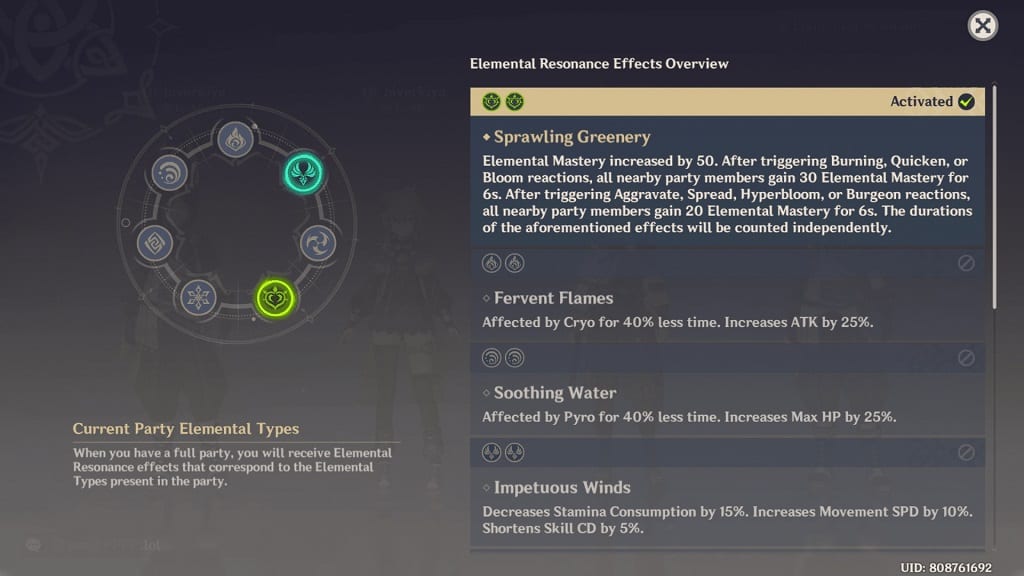
Dendro Resonance: It increases Elemental Mastery by 50 units and further increases if you trigger specific Dendro reactions. If you trigger main Dendro reactions, then the Elemental Mastery increases by 30 units, and sub-reactions increase it by 20 units for all party members.

Aura: It is an element that’s applied to an enemy. That’s as simple as it is. Let’s suppose you attack an enemy with Kaeya’s elemental skill. Then that enemy will have a Cryo aura on it.
Basically, the first element you apply to the enemy becomes an aura on it. Remember that Geo and Anemo don’t apply any aura to enemies.

Trigger: As for the Trigger, it’s the element you apply on top of the aura. Let’s take an example to better understand it. If you apply the Cryo on an enemy and then use Klee’s normal attack to make a reaction, then Klee’s Pyro element is the trigger element on the Cryo aura.
Usually, the character who triggers a reaction is important as their stats are considered in the damage output. Here, Kaeya is applying Cryo aura and Barbara is triggering Freeze reaction with Hydro element.
Sub-reaction: Though there have been sub-reactions in the game, they weren’t paid much attention to. Put simply, a sub-reaction is a reaction on top of a reaction. A fine example is a Shatter reaction. Once you Freeze an enemy, you can hit them with a Claymore or heavy attack to trigger a Shatter reaction that deals physical damage.
I encountered it when I was using Klee in the overworld. I didn’t like that Klee triggered a shatter reaction on frozen enemies, as her normal attacks are considered heavy attacks. Notice the white damage number that indicates physical damage and ice getting shattered.
Additive Reaction: Additive reaction is a new reaction concept in the case of Dendro reactions, where your damage output is increased by a certain number. I actually found this term in Zajef’s video and loved the explanation. In these reactions, depending on the type of reaction you are looking to trigger on an enemy, you may need to tweak your build.
The damage in these reactions gets added, so stats like character level, Elemental mastery, or damage percentage will contribute to these reactions. Quicken, Aggravate, and Spread is fine examples of this reaction, and I will go over them in their sections with examples.
Transformative Reaction: These are usually the type of reactions that depend on your Character level and Elemental mastery. You should level up characters like Sucrose, Kazuha, or Venti to the maximum level and invest in Elemental mastery to benefit from the swirl reaction.
There are Transformative Reactions like Overload, Electro-charged, and so on. Additionally, the new Dendro reactions like Bloom, Hyperbloom, Burning, and Burgeon are also in the same category. Here, Fischl and Barbara are helping to trigger an electro-charged reaction on a ruin guard.
The key difference between Transformative and Additive reactions is that Transformative reactions have a separate damage number. In contrast, the elemental damage number is higher in the case of Additive reactions.
Transformative reactions have two damage numbers, and Additive reaction has a single damage number. Well, that’s how I see them.
Burning

I was waiting for Dendro reactions to come to the game so that I could do Burning Damage to those annoying Dendro samachurls. I remember getting caught in thorny bushes those samachurls spawned and applying Pyro on them to burn them away.
Finally, we have a Burning reaction in the game. As observed, it happens with you react to Dendro with Pyro. Once you do that, you will deal consistent Pyro damage to the enemies for a few seconds.
You have to keep applying Dendro on Pyro to keep the Burning consistent on the enemies. You will deal Pyro damage in a short duration but to keep that long, you have to apply Dendro again.
I loved Zajef’s analogy to this reaction that you have to feed wood to the fire to keep it alive; otherwise, the Dendro will be consumed by the Pyro aura. There are around 8 instances of Pyro damage that you will deal with in burning.
You can extend the duration by adding more Dendro.
Here, after applying Pyro you can apply Dendro to trigger Burning reaction and keep adding Dendro to extend reaction’s duration.
Damage-wise, it’s not that great, but you can use a Cryo character to trigger a melt reaction. However, overall, burning is not that apt even for using an extra Cryo unit to access melt reactions.
For now, I would say it’s better to know that it’s a good reaction but beware that it can also damage your character if you are on grass. I lost my Tighnari so many times using him with Bennett and burning myself to death.
Bloom
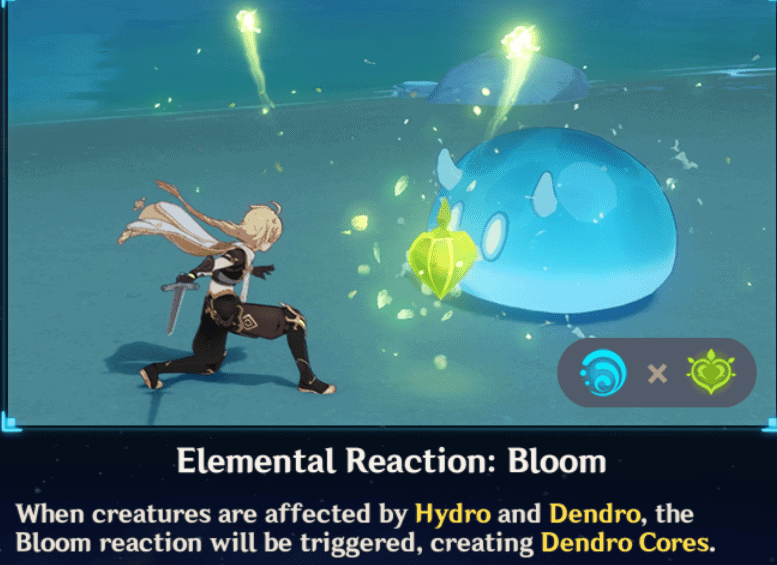
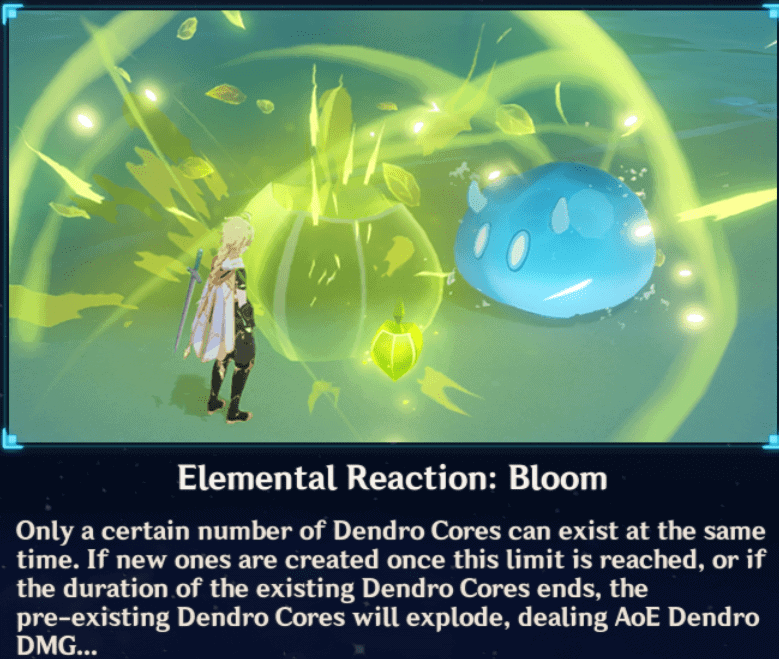
Bloom is one of the cutest reactions for me. I thought the seed would heal me if I picked it up, and to my surprise, it exploded in front of my face. Luckily, the Bloom reactions do minor damage even if you are in its blast radius.
When Dendro comes in contact with Hydro, a seed appears in front of you. If you don’t interact with the seed, it explodes after 6 seconds, or you reach a limit of 5 seeds; the oldest one explodes.
I actually got an achievement after triggering Bloom reaction. Well, that was unexpected.
Notice that Bloom’s self damage is quite low. Even if you are in the blast radius you will be inflicted with 5% damage which is quite trivial.
A fun fact about Bloom is that you can trigger it after a freeze reaction. Technically, Dendro and Cryo aura will co-exist and after the Freeze reaction, Cryo aura will go away and you can apply Hydro to trigger a bloom reaction.
These seeds can be pulled in with Anemo characters’ abilities, and you can group enemies with them to deal with area Dendro damage. Seeds explode to deal area Dendro damage to the enemies, but this is not where it ends.
Blooms even have sub-reactions that can be triggered if you apply an extra element on Bloom. I would say you should apply Dendro first, then use Hydro on enemies to spawn seeds on the ground.
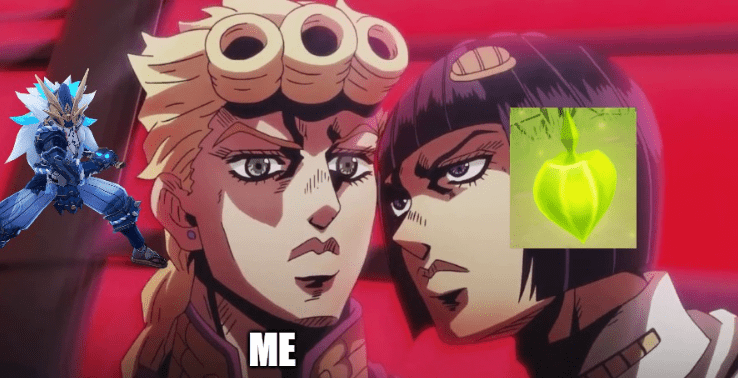

Coming to Bloom’s sub-reactions, once you apply Bloom, you can either Trigger Burgeon or Hyperbloom by applying Pyro or Electro, respectively. Both sub-reactions Burgeon and Hyperbloom have better Damage than Bloom reaction, so it’s good to know about them if you want to use a Bloom team.
Burgeon
Burgeon sounds like it relates to burning, meaning Pyro will be involved. Well, it sure is. I would say it enhances the Area Dendro damage of your Bloom seed if you react it with Pyro. You can create the seed with Hydro and Dendro and then trigger Burgeon reaction with Pyro application. It deals area-wide damage to the enemies.
Like Bloom seed’s explosion, Burgeon can also deal damage to your character. The damage of this reaction is better than a normal Bloom explosion. It is similar to detonating a small mine at enemies. You can use Anemo characters here to group up the seeds and have Pyro swirls to trigger the seeds.
HyperBloom
Once you have a seed on the ground, you can apply Electro on it to trigger a Hyperbloom reaction that creates a homing projectile hitting a single enemy. The damage, of course, is Dendro damage to the enemy.
So, for you to trigger this reaction, you have to create a seed by reacting Dendro and Hydro, then apply Electro on the created seed. Keep in mind that it may take a few seconds for the projectile to hit the enemy; it’s not instant.
Catalyze
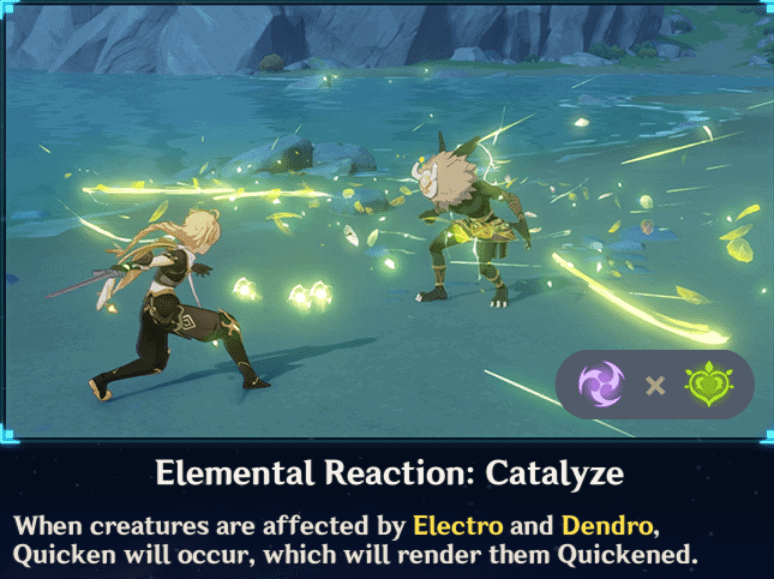
Catalyze will occur when Electro and Dendro come in contact with each other and applies for Quicken Status on the enemies. Once you have Quicken status on enemies, you can access Spread and Aggravate sub-reactions.
There’s not much to Catalyze, but it’s more to the Quicken status and the sub-reactions that get unlocked to access. Let’s go over them one by one.
Quicken Status

I love Quicken’s reactions. I’m more into Electro and Dendro characters combination. Quicken happens when you combine Dendro and Electro, and the enemies get a Quickened status.
You can observe them as they will have a lightning aura to them and further apply Dendro or Electro to Trigger sub-reactions. You can even apply Pyro or Hydro on the Quicken reaction that will trigger Burning or Bloom reactions, respectively.
Quicken has two sub-reactions, which are pretty much the same in their application. Once you have Quicken status on an enemy, you can either apply Dendro or Electro to buff those elements’ damage. The best part about the Quicken status is that it remains on the enemy after you apply Electro or Dendro on the enemy.
You can keep on going with either of the elements to deal with boosted damage. However, the Quicken aura will be removed if you use Pyro or Hydro characters. In a nutshell, Aggravate and Spread won’t remove the Quicken status, but Bloom or Burning will.
Fun fact: Quicken can simultaneously have Dendro, Electro, or Cryo aura on the enemy, and you can trigger further reactions. Also, these reactions are one of my favorites. You can benefit from stats like Damage bonuses, CRIT rate/damage, and Elemental mastery.
Notice that Amber can trigger Burning reaction on Quicken and after that you can feed Dendro to continue the reaction. I won’t advise you to build for Burning reaction because the damage isn’t that good.
Likewise,you can trigger Bloom reaction on Quicken aura to spawn a Bloom seed. However, the damage potential of Aggravate and Spread is good so you don’t need to mix Hydro or Pyro characters because they can consume the Quicken aura.
Spread
Now, suppose you have Quicken status on an enemy. In that case, you can have a Dendro character to apply Dendro and deal better Dendro damage. The base damage of Spread is greater than Aggravate. There aren’t many sources of external buffs for Dendro damage.
As you know, Viridescent Venerer is goto for most elemental damage teams for elemental resistance shred, but you cannot swirl Dendro. So, we will have to wait for characters or weapons which can boost Dendro damage. One fine example is Zhongli’s shield, which can shred elemental resistance from enemies.
Aggravate
Aggravate is by far one of my personal favorite Dendro reactions because I usually play Electro characters, which helps to enhance the Electro damage. Once you have Quicken status on an enemy, you can trigger Aggravate by applying Electro on them and dealing greater Electro damage to them.
The best part is that the Quicken status stays on the enemy even after you trigger the Aggravate reaction, which means you can keep going on. Even if you lose the Quicken status, you can apply Dendro on the enemies and switch back to your Electro characters. Notice in the video that Fischl’s damage increased in Aggravate after the Quicken status.
This is an Additive reaction, where the extra damage gets added to the reaction damage and doesn’t appear as a separate damage number.
Unlike Spread, where you cannot swirl the Dendro element, that’s not a problem with Electro. You can use an Anemo unit in this reaction team and take benefit from Swirls and even swirls that deal with Aggravate Damage. Apply Dendro and Electro, and once you have Quicken status, keep going with Aggravate damage by using Electro swirls.
However, the difference is that Electro swirls that will trigger Aggravate will be Transformative Reactions. Anemo units depend on Elemental mastery and Character level, so there you have a twist in swirling.
Dendro Reaction Questions
Question: Which characters can use the Dendro element in version 3.0?
Answer: As of the new update, three Dendro characters are available in the game. Tighnari, Dendro Traveler, and Collei are the ones who can use the Dendro element. Collei is a free character you receive when you reach the Sumeru region. She’s available quite early before you dive into the world quest and major exploration of the area. I got Tighnari, a 5-star bow character, and happy to use a Dendro bow character for exploration.
Some exploration mechanics will be easy if you have a Dendro character who uses a bow. Personally, exploration-wise, I’m happy using Tighnari, although I didn’t have any plans to pull him from the banner. I was looking for Collei and got an early pity in less than 20 pulls for the first time, and BAM! Tighnari came home.
Question: Where can I learn more about the Dendro reactions?
Answer: I’m more than happy to share a few resources from where you can revise some Dendro reactions. If you don’t know, there’s Hoyolab app where you can join the Genshin Impact community and learn more about community work. Some awesome people have made good posts on the new content that comes into the game and always share their findings there.
Usually, when I have to confirm some facts, I jump onto these posts and test them myself to confirm things. I found this post to be quite cute and informative at the same time. This one’s a basic overview of what the Dendro reactions are if you just want to know about the Dendro reactions and do not care much about the meta.
Another source can be Zajef’s youtube channel, where you can find his video for Dendro’s reaction and go in-depth into them. He has emphasized advanced theory-crafting concepts, and if you want to literally know every single bit about the elements, then it’s a good source. Other good Youtubers, Discord servers, and Reddit posts are informative in themselves.
But whichever source you follow, just practice that yourself in the game for once. I think you can even discover new things in the game if you experiment and explore on your own. However, sometimes it’s good to leverage the power of a strong community and learn things and share with each other.
Question: How does Dendro react to Geo, Anemo, or Cryo elements?
Answer: I won’t go into the details much, but a shorter explanation could be that the Cryo can co-exist with the Dendro element. After you apply the Cryo element on an enemy with the Dendro element, you can apply the Hydro element to trigger a Freeze reaction. That’s just one case as Cryo can also act with other elements. As for Anemo or Geo elements are like neutral elements in case of aura application and don’t get applied on enemies.
You can trigger a reaction like a Swirl with Anemo or Crystallize with Geo. Still, enemies don’t get Anemo or Geo status on them. I like this game mechanic because it ensures that there aren’t a lot of reactions in the game. I agree that we have plenty of reactions in the game but over time, many players have learned them and stuck to the meta.
I hope we get better characters in the future. The meta diverts a bit towards Additive reactions to keep things easier. Well, that’s what I hope for. Who knows what Hoyoverse has in store for us?
Dendro Genshin Impact Guide: Final Thoughts
Dendro reactions are a game changer, and that’s a solid fact. Not only have they given plenty of reactions to the players, but adding sub-reactions in Additive reactions is also an awesome opportunity to diversify teams. Some standard characters like Xiangling, Xingqiu, and Bennett are goto for most of the team compositions.
Still, with the addition of Dendro reactions, players can explore more in team variation. I’m more inclined towards Quicken and Spread reactions because I sometimes love using single-element teams. There have been cases where I used an overloaded team with Klee, Zhongli, Fischl, and Beidou, but that was way too situational.
I’m sure that as there have been alleged claims on social media platforms about new characters in the future, there will be game-changing teams who will ace the abyss. But for now, the best thing is to invest your time in learning these reactions so that you can form your own team. What could be better than forming a team of characters you love and tailored to your needs?
That was all from my end for my first guide related to the Dendro reactions and their unique aspects. I wish you the best in Sumeru exploration, and don’t forget to enjoy the soothing music! Undeniably, Sumeru is the best region we have received so far, and Hoyoverse has proven once again how beautiful a game can be. Adios, and I’ll see you soon in some interesting Sumeru guides! Stay tuned.
- Genshin Impact Fontaine Region Guide - January 5, 2024
- Genshin Impact Wild Fairies of Erinnyes Guide - December 17, 2023
- Genshin Impact All Dendroculus Locations - December 12, 2023

